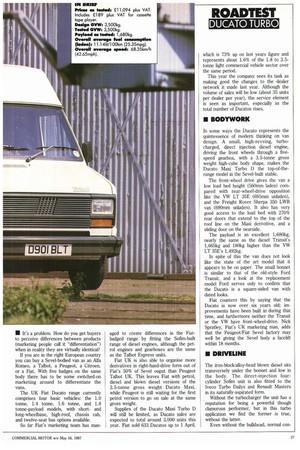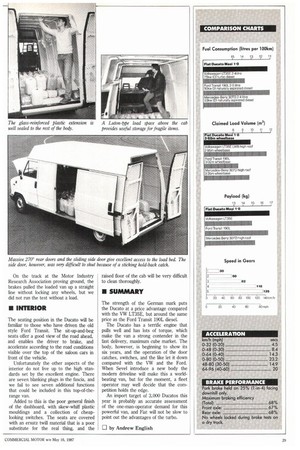• It's a problem. How do you get buyers to
Page 29

Page 30

Page 31

If you've noticed an error in this article please click here to report it so we can fix it.
perceive differences between products (marketing people call it "differentiation") when in reality they are virtually identical?
If you are in the right European country you can buy a Sevel-bodied van as an Ma Romeo, a Talbot, a Peugeot, a Citroen, or a Fiat. With five badges on the same body there has to be some switched-on marketing around to differentiate the vans.
The UK Fiat Ducato range currently comprises four basic vehicles: the 1.0 tonne, 1.4 tonne, 1.6 tonne, and 1.8 tonne-payload models, with shortand long-wheelbase, high-roof, chassis cab, and twelve-seat bus options available.
So far Fiat's marketing team has man aged to create differences in the Fiatbadged range by fitting the Sofim-built range of diesel engines, although the petrol engines and gearboxes are the same as the Talbot Express units.
Fiat UK is also able to organise more derivatives in right-hand-drive form out of Fiat's 50% of Sevel ouput than Peugeot Talbot UK. This leaves Fiat with petrol, diesel and blown diesel versions of the 3.5-tonne gross weight Ducato Maxi, while Peugeot is still waiting for the first petrol version to go on sale at the same gross weight.
Supplies of the Ducato Maxi Turbo D will still be limited, as Ducato sales are expected to total around 3,000 units this year. Fiat sold 633 Ducatos up to 1 April, which is 73% up on last years figure and represents about 1.6% of the 1.8 to 3.5tonne light commercial vehicle sector over the same period.
This year the company sees its task as making good the changes to the dealer network it made last year. Although the volume of sales will be low (about 35 units per dealer per year), the service element is seen as important, especially as the total number of Ducatos rises.
BODYWORK
In some ways the Ducato represents the quintessence of modern thinking on van design. A small, high-revving, turbocharged, direct injection diesel engine, driving the front wheels through a fivespeed gearbox, with a 3.5-tonne gross weight high-cube body shape, makes the Ducato Maxi Turbo D the top-of-therange model in the Sevel-built stable.
The front-wheel drive gives the van a low load bed height (560mm laden) compared with rear-wheel-drive opposition like the VW LT 35E (695mrn unladen), and the Freight Rover Sherpa 350 LWB van (690mm unladen). It also has very good access to the load bed with 270% rear doors that extend to the top of the roof line on the Maxi derivative, and a sliding door on the nearside.
The payload is an excellent 1,680kg, nearly the same as the diesel Transit's 1,665kg and 180kg higher than the VW LT 35E's 1,492kg.
In spite of this the van does not look like the state of the art model that it appears to be on paper. The small bonnet is similar to that of the old-style Ford Transit, and a look at the replacement model Ford serves only to confirm that the Ducato is a square-sided van with dated looks.
Fiat counters this by saying that the Ducato is now over six years old; improvements have been built in during that time, and furthermore neither the Transit or the VW have front-wheel-drive. Nick Spratley, Fiat's UK marketing man, adds that the Peugeot/Fiat Sevel factory may well be giving the Sevel body a facelift within 18 months.
• DRIVELINE
The iron-block/alloy-head blown diesel sits transversely under the bonnet and low in the body. The direct-injection fourcylinder Sofim unit is also fitted to the Iveco Turbo Dailys and Renault Masters in its naturally-aspirated form.
Without the turbocharger the unit has a reputation for being a powerful though clamorous performer, but in this turbo application we find the former is true, without the latter.
Even without the bulkhead, normal con versation is possible at motorway speeds. The VW LT35E we tested in January (CM 17 January), had an an in-cab noise level of 83dB(A) at 112km/h (70mph) — the Ducato's noise level at the same speed is only 79dB(A).
• PERFORMANCE
The performance lives up to the expectations created by Fiat's marketing campaign. Acceleration times are slightly faster than the VW LT35E with the sixcylinder turbocharged engine, and way ahead of the Ford Transit 190L diesel we tested last year (CM 20 September).
• TRANSMISSION
As well as showing the competition the way home in terms of performance, the Ducato delivers its power well too. The engine revs well in all the gears, which overcomes the particularly long gap between first and second gear without embarrassment. The engine is so flexible that up to two gears can be missed in an up change without sheepish looks at the passengers.
This is a useful feature, given the sloppy nature of the gear lever gate. The gears are well chosen for the 3.5-tonne gross weight, and the Peugeot Societe Anonyme gearbox fitted to most of the Sevel-built vans transmits the power of the turbo engine without complaint. The gearchange, however, is very vague, with the lever flopping about in every gear and no positive indication of neutral.
This characteristic is not a problem when moving up and down the box sequentially, but where a gear has to be selected in a hurry the box rapidly becomes full of neutrals – much to the driver's chagrin.
The situation is not helped by the very weak clutch on the test van, which failed to start the van on gradients steeper than 25% (1-in-5), when fully loaded. On an 25% uphill start, with first gear meshed, the accelerator fully depressed, and the clutch engaged, the van made reasonable progress . . back down the hill.
• SUSPENSION AND HANDLING
To give the Ducato Maxi a bit more strength than the low-roof, shortwheelbase derivatives, the front frame, floor pan, side panels, and roof have been uprated. Larger front brakes, wheel rims, and bigger dampers are also fitted. The result is a strong monocoque with reasonable suspension travel that handles the bumps well.
Taking corners with a full load results in some understeer, but the van has neutral handling and once in a corner the suspension soaks up the bumps and the steering remains light.
Unladen, the Ducato's rigid beam rear axle hops about on poor roads, but the 16-inch rear wheels retain their grip.
Other manufacturers, look askance at front-wheel drive but the acceleration times prove that the traction is there. There is a strong self-centring action under hard acceleration, but otherwise the FWD system works very well, considering the van's gross weight.
Only if the van is driven off-road does the front-wheel drive cause any problems, as weight transfer to the rear wheels takes the grip away from the front, and the tyres scrabble uselessly for grip.
• BRAKING
King and Taylor of Godalming, Surrey kindly carried out a rolling road brake test on the van, and obtained a respectable 68% overall efficiency. The fitter noticed, however, that the rear axle load compensator was stuck wide open, giving full brake pressure to the rear brakes even when unladen. On the track at the Motor Industry Research Association proving ground, the brakes pulled the loaded van up a straight line without locking any wheels, but we did not run the test without a load.
• INTERIOR
The seating position in the Ducato will be familiar to those who have driven the old style Ford Transit. The sit-up-and-beg seats offer a good view of the road ahead, and enables the driver to brake, and accelerate according to the road conditions visible over the top of the saloon cars in front of the vehicle.
Unfortunately the other aspects of the interior do not live up to the high standards set by the excellent engine. There are seven blanking plugs in the fascia, and we fail to see seven additional functions that could be included in this top-of-therange van.
Added to this is the poor general finish of the dashboard, with skew-whiff plastic mouldings and a collection of cheaplooking switches. The seats are covered with an ersatz twill material that is a poor substitute for the real thing, and the raised floor of the cab will be very difficult to clean thoroughly.
• SUMMARY
The strength of the German mark puts the Ducato at a price advantage compared with the VW LT35E, but around the same price as the Ford Transit 190L diesel.
The Ducato has a terrific engine that pulls well and has lots of torque, which make the van a strong contender in the fast delivery, maximum cube market. The body, however, is beginning to show its six years, and the operation of the door catches, switches, and the like let it down compared with the VW and the Ford. When Sevel introduce a new body the modern driveline will make this a worldbeating van, but for the moment, a fleet operator may well decide that the competition holds the edge.
An import target of 3,000 Ducatos this year is probably an accurate assessment of the one-man-operator demand for this powerful van, and Fiat will not be slow to point out the advantages of the turbo.
LI by Andrew English












































































